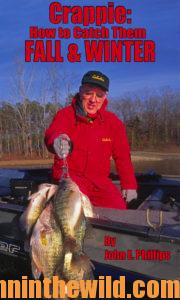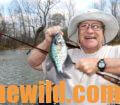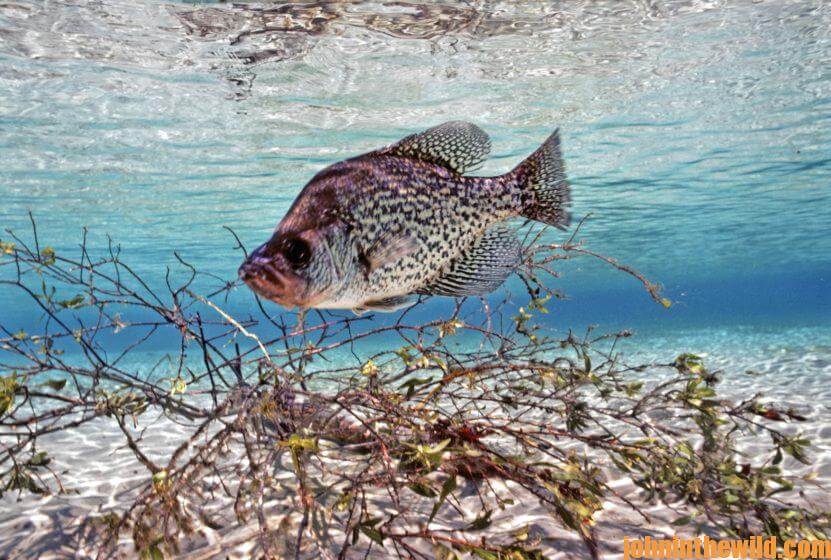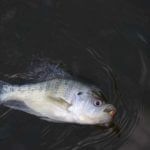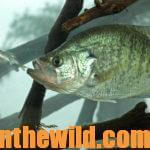Editor’s Note: This fall there’s been almost never-before very-high temperatures in the 90+ range. Where I live near Birmingham, Alabama, we’ve had 6 weeks of 95+ temperatures from late August through the first part of October. So, crappie fishermen must use summertime tactics to catch October crappie across much of the South. In other sections of the country, anglers will catch crappie with fall strategies. With 4 feet of snow falling in the U.S. Northwest the first week of October, some anglers must use winter methods to catch crappie there. This week, we’ll look at catching crappie now. Today’s crappie anglers are catching more and bigger crappie than ever before by going deep for crappie, which takes planning, close observation and special lure techniques for warm-weather crappie.
Many crappiers consider fishing in the fall of the year like fishing the spawn. One year, the air had the promise of Jack Frost in it as my friend and I snaked his little aluminum johnboat through the stump rows in an oxbow lake – the same type of area we generally fished in the spring. But in mid-November, a lightweight jacket made fishing much more comfortable.
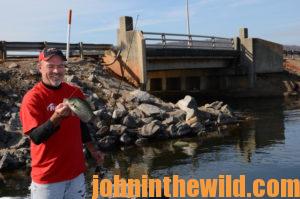 “Don’t let your jig get more than a foot deep,” the veteran angler coached me. “The crappie will hold just under the surface, tight to the cover. Swim your jig right beside the stump just like a small minnow. If you can bump the stump with the jig, your bait will look even more lifelike.” Almost immediately, my graphite pole dove for the surface of the water as I put pressure on the butt of the pole. “Get the net,” I shrieked to him. “I can’t pull this one over the side of the boat.” Not docile at all, the fish showed more grit and fight than I liked a big crappie to demonstrate. As I questioned myself and my angling ability to land my fish, the big pearl-colored and speckled sides of the slab showed beneath the surface. With the expertise of more than 40 years of crappie-fishing experience, my buddy slid the dip net under the wide-mouthed crappie and brought the fish on-board.
“Don’t let your jig get more than a foot deep,” the veteran angler coached me. “The crappie will hold just under the surface, tight to the cover. Swim your jig right beside the stump just like a small minnow. If you can bump the stump with the jig, your bait will look even more lifelike.” Almost immediately, my graphite pole dove for the surface of the water as I put pressure on the butt of the pole. “Get the net,” I shrieked to him. “I can’t pull this one over the side of the boat.” Not docile at all, the fish showed more grit and fight than I liked a big crappie to demonstrate. As I questioned myself and my angling ability to land my fish, the big pearl-colored and speckled sides of the slab showed beneath the surface. With the expertise of more than 40 years of crappie-fishing experience, my buddy slid the dip net under the wide-mouthed crappie and brought the fish on-board.
Fishing in fall weather can produce some of the biggest papermouths of the year. Many anglers call early fall fishing for crappie the second spawn. When the crappie find the surface temperature of the water cooler than the bottom temperature, the fish will move into that shallow water and begin to feed as actively as they have during the spawn before the lake turns over for the winter. Here are some tips to fish successfully for crappie in fall-like weather.
* Look for Visible Cover and What Equipment to Use:
Fish rivers that home numerous stumps and stick-ups in the fall and early winter. The largest crappie most often will be next to single, isolated sticks. A big crappie likes to lie in the shade of a single stick or a small stump and protects its ambush point by running smaller crappie away. When a bait fish comes by that stick or stump, the crappie will dart out and grab it. I let the isolated stick-ups rest for two or three days after fishing them.
Many oxbow crappie anglers prefer to fish 6-8 pound test line on 8-10 foot graphite poles with 1/24- and 1/32-ounce jigs. Rather than moving the jigs up and down beside the stumps, ease the jigs into the water, and slowly swim them around the stump or stick-up. If you swim the jig slowly around the stump, you present the bait more naturally to the crappie. Then start swimming the jig 3-4 inches below the surface. If you don’t catch a crappie at that depth, lower the jig to a foot or 1-1/2 feet below the surface. Continue to lower the jig. Once you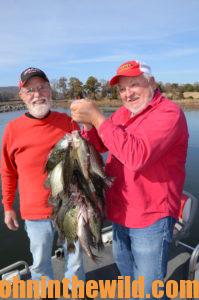 catch a crappie, you’ll know at what depth you’ll locate the fish holding on that day.
catch a crappie, you’ll know at what depth you’ll locate the fish holding on that day.
* Fish Points:
The increase in the numbers of bass fishermen has meant good news for crappie fishermen. Bass anglers consider main river and creek points the most-productive places to catch bass at any time of the year and often will build underwater brush shelters at varying depths along these points for spots where bass and crappie will concentrate. The water temperature and water clarity will determine at what depth in which particular brush pile the crappie will concentrate throughout the fall and the winter. In the early fall, the fish often remain in the brush closest to the bank. Later in the fall and the winter, the fish will move further out on the point to the deep-water brush piles closest to the main river or creek channels.
Use your depth finder to motor back and forth across a point from the shallow to the deep water, and find the brush shelters on that point at different depths. To take crappie, drop a marker buoy either to the left or the right of the brush shelter you locate. Back away from the marker, and cast to the brush, using small line on light tackle. The many weedless crappie jigs on the market today will allow you to let your jig swim into the brush, bounce through the brush and come out of the brush without hanging-up. Too, try fishing brush piles on points by fishing vertically with minnows and a bobber.
* Bump Stumps:
Fish a 3/4-ounce, Hopkins jigging spoon (https://hopkinslures.com/) on 17-20 pound test line with a medium-action bait-casting rod and reel. Utilize your depth finder to locate stumps and brush on the edges of river and creek channels. Let your jigging spoon down slowly, until you touch the stump or the brush. Hold your rod tip parallel to the water. Then slowly, very slowly, raise and lower your rod tip about 6 inches. Resist the urge to rip the jigging spoon up and let it fall back. Remain in contact with the bait each time you carefully lift and lower the rod tip. The large crappie will attack that big, slow-moving jigging spoon most people only use to catch bass.
 Use Various Fall Techniques with Charlie Ingram:
Use Various Fall Techniques with Charlie Ingram:
* Slow-Troll Minnows and Jigs:
During the fall of the year, the majority of crappie will relate to some type of bottom break – making the edges of old creek and river channels productive crappie hot spots. However, because these creek and river channels may extend for miles, you may have difficulty pinpointing schools of crappie. But you can catch these crappie, if you know how to slow-troll.
Mark-off 200 to 300 yards of a creek channel with buoys. Then use minnows and a slip bobber on poles with reels to let your minnows down to within a foot of the bottom. Move the boat very slowly along the edge of the creek channel. When your minnows pass by the stumps, brush and cover where the crappie hold, the crappie will swim out of their hiding places and attack. The slower you move, the more crappie you’ll take. This same tactic also will produce for jig fishermen, and you either can fish jigs with or without a bobber.
To learn more about crappie fishing in the fall and winter, check out John E. Phillips’ book, “Crappie: How to Catch Them Fall & Winter,” available in Kindle, print and Audible at http://amzn.to/16AzIZi.
Tomorrow: Learning More Fall Crappie Tactics